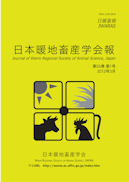Volume 55, Issue 1
Displaying 1-7 of 7 articles from this issue
- |<
- <
- 1
- >
- >|
Review Article
-
2012Volume 55Issue 1 Pages 1-7
Published: March 31, 2012
Released on J-STAGE: July 02, 2012
Download PDF (530K)
Original Article (Full Paper)
-
2012Volume 55Issue 1 Pages 9-15
Published: March 31, 2012
Released on J-STAGE: July 02, 2012
Download PDF (1220K) -
2012Volume 55Issue 1 Pages 17-26
Published: March 31, 2012
Released on J-STAGE: July 02, 2012
Download PDF (2025K) -
2012Volume 55Issue 1 Pages 27-31
Published: March 31, 2012
Released on J-STAGE: July 02, 2012
Download PDF (978K) -
2012Volume 55Issue 1 Pages 33-40
Published: March 31, 2012
Released on J-STAGE: July 02, 2012
Download PDF (1626K) -
2012Volume 55Issue 1 Pages 41-47
Published: March 31, 2012
Released on J-STAGE: July 02, 2012
Download PDF (1156K)
Original Article (Short Communication)
-
2012Volume 55Issue 1 Pages 49-53
Published: March 31, 2012
Released on J-STAGE: July 02, 2012
Download PDF (912K)
- |<
- <
- 1
- >
- >|
